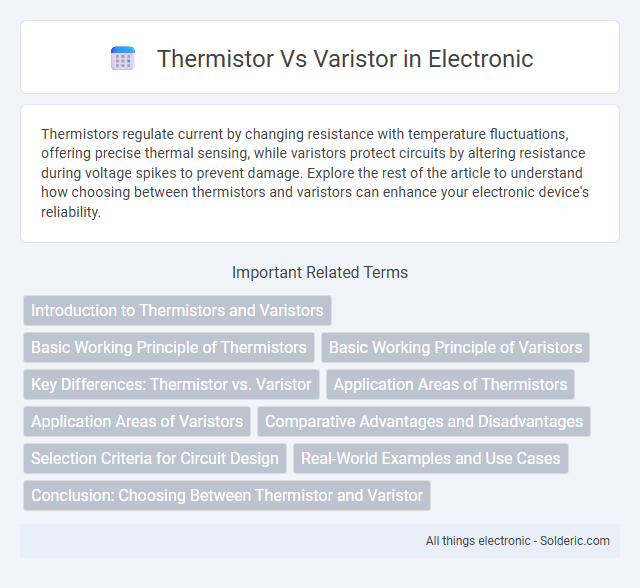Thermistors regulate current by changing resistance with temperature fluctuations, offering precise thermal sensing, while varistors protect circuits by altering resistance during voltage spikes to prevent damage. Explore the rest of the article to understand how choosing between thermistors and varistors can enhance your electronic device's reliability.
Comparison Table
| Feature | Thermistor | Varistor |
|---|---|---|
| Function | Temperature-dependent resistor for temperature sensing or control | Voltage-dependent resistor for overvoltage protection |
| Operation Principle | Resistance changes with temperature (NTC or PTC types) | Resistance decreases sharply when voltage exceeds a threshold |
| Material | Metal oxides like manganese, cobalt, nickel (semiconductors) | Metal oxide varistor (MOV), typically zinc oxide-based |
| Typical Applications | Temperature measurement, circuit protection against thermal overload | Surge protection in power supplies, lightning arrestors |
| Response Time | Milliseconds to seconds (temperature changes) | Nanoseconds to microseconds (voltage surge response) |
| Voltage Rating | Low voltage, dependent on thermistor type | High voltage rating, designed for transient surge absorption |
| Behavior under Stress | Gradual resistance variation with temperature | Sudden resistance drop at voltage threshold |
| Typical Symbol | Temperature sensor symbol, resistor with temperature curve | Resistor with a voltage clamp indication |
Introduction to Thermistors and Varistors
Thermistors are temperature-sensitive resistors commonly used in temperature measurement and control applications due to their predictable change in resistance with temperature variations. Varistors, or voltage-dependent resistors, protect circuits from voltage spikes by exhibiting a nonlinear resistance that decreases sharply at a specific voltage threshold. Both components play critical roles in electronic circuit protection and regulation, with thermistors primarily managing thermal changes and varistors safeguarding against transient voltage surges.
Basic Working Principle of Thermistors
Thermistors operate based on the principle that their electrical resistance varies significantly with temperature, typically displaying either a negative temperature coefficient (NTC) or positive temperature coefficient (PTC). In NTC thermistors, resistance decreases as temperature increases, making them ideal for temperature sensing and inrush current limiting. PTC thermistors exhibit increased resistance with rising temperature, providing effective overcurrent protection by limiting current flow during overheating conditions.
Basic Working Principle of Varistors
Varistors operate based on a nonlinear voltage-current characteristic, where their resistance changes significantly with the applied voltage, protecting circuits from voltage spikes by clamping high voltage to a safe level. Made of metal oxide materials, typically zinc oxide, varistors exhibit high resistance at low voltages and dramatically lower resistance when voltage exceeds a threshold, allowing excess current to pass through and prevent damage. This behavior contrasts with thermistors, which primarily change resistance in response to temperature variations rather than voltage fluctuations.
Key Differences: Thermistor vs. Varistor
Thermistors and varistors differ primarily in function and response to electrical changes; thermistors regulate temperature by changing resistance with heat, while varistors protect circuits by altering resistance to voltage spikes. Thermistors are commonly used in temperature sensing and control applications, whereas varistors serve as surge protectors in electrical devices. Your choice depends on whether temperature measurement or voltage surge protection is required in your system.
Application Areas of Thermistors
Thermistors are widely used in temperature sensing and control applications, such as in HVAC systems, medical devices, and automotive temperature monitoring. Their high sensitivity to temperature changes makes them ideal for precise environmental measurement and protection circuits. You can find thermistors in battery management systems and consumer electronics to prevent overheating and ensure optimal performance.
Application Areas of Varistors
Varistors are primarily used in surge protection applications to safeguard electronic circuits from voltage spikes caused by lightning strikes, power surges, and transient voltage events. They are commonly found in power strips, telecommunications equipment, automotive electronics, and consumer appliances to improve device reliability and longevity. Understanding the unique application areas of varistors can help you select the right component for effective voltage regulation and circuit protection.
Comparative Advantages and Disadvantages
Thermistors offer precise temperature measurement and control with high sensitivity but are limited by their narrow temperature range and slower response times compared to varistors. Varistors excel at protecting circuits from voltage surges with rapid response and broad voltage handling but lack the temperature sensitivity of thermistors. Your choice depends on whether accurate thermal detection or robust surge protection is the priority in your application.
Selection Criteria for Circuit Design
Selecting between a thermistor and a varistor depends on the specific circuit protection needs, such as temperature sensitivity or transient voltage suppression. Thermistors are ideal for temperature monitoring and inrush current limiting due to their predictable resistance change with temperature. Your choice hinges on whether you prioritize thermal response accuracy or voltage spike absorption in your circuit design.
Real-World Examples and Use Cases
Thermistors are commonly used in temperature sensing applications such as HVAC systems, medical devices, and battery management systems, where precise temperature monitoring is critical. Varistors protect electronic circuits from voltage spikes in power supplies, surge protectors, and telecommunications equipment, ensuring longevity and safety. Your choice between thermistor or varistor depends on whether you need temperature measurement or voltage surge protection in your device.
Conclusion: Choosing Between Thermistor and Varistor
Choosing between a thermistor and a varistor depends on your specific application requirements for temperature sensitivity or voltage surge protection. Thermistors excel in precise temperature measurement and control due to their resistance varying significantly with temperature changes. Varistors are ideal for safeguarding electronic circuits by clamping voltage spikes, ensuring reliable protection against transient overvoltages.
Thermistor vs varistor Infographic

 solderic.com
solderic.com